Sixties and Seventies through the Nineties
Back to flies again. So far we've raced through fifty years of Western fly tying from 1915 to the end of the 1950s. A lot happened then and so too in the next thirty years--from the 1970's through to the turn of the century.
I'll do my best to zoom through these years with a narrative that isn't too long and arduous. This is the beginning of the contemporary era. Most readers will already be familiar with the important flies of this time. Most readers won't need me to tell them what a great fly the Copper John the Zebra Midge or the Clouser are. They already know. I'll mention most of them anyway but I will try to pick up the pace a bit. The fun stuff is yet to come, when we see what Montana guides and outfitters plus a few talented tiers are actually making today.
Swischer Richards and Craig Mathews' Sparkle Dun
I mentioned the Swisher Richards flies already, in an earlier section. Their work really opened things up. The Swisher/Richards Compara Dun was a cool fly but perhaps a bit hard to keep afloat in some Western contexts. This is an old story. Don Martinez struggled with the conflict between his love for classic Catskill patterns and the bushy Wulff flies that were starting to sell so well out West. That was a big freestone river conflict.
A similar tension began to be all over again in the Western smooth water contexts. When the Henry's Fork the Madison in the Park and the Firehole started to carve out a niche for something a bit less intimidating than a Humpy the Swisher/Richards flies looked like just the ticket. But maybe they still needed a bit more floatation horse power. In the late 1980s Craig Matthews of West Yellowstone first started tying his ground breaking Sparkle Duns, which were a lot like a Compara Dun with a hefty Zelon tail that might even look like a trailing nymphal shuck. What a great fly. This is one of my favorite dry flies. This one put money in my pocket when I was guiding on the spring creeks over near Livingston Montana.
Rene Harrop
Any chronicle of Western fly tying has to pay tribute to Rene Harrop. Rene is one of great fly tiers in any context. Late in Tom Morgan's life Tom put together a small commercial project which consisted of a beautifully built dovetailed hardwood box with a brass hinged lid, with a manually pressed and printed book inside, hand made by Tom's talented wife Gerri Carlson. The box included a series of Tom's most cherished flies. The book contained Tom stories about those flies. Craig Mathews and Rene Harrop tied the actual flies. Both are, to say the least, outstanding tiers. Rene's work in particular was a sight to behold. I have never seen such beautifully proportioned flies. Ever. In the smaller sizes any minor sizing anomaly in any part of a fly makes a proportionately bigger difference. Rene's flies--the ones he tied to go with Tom and Gerri's little box and book--were astonishingly beautiful. And all so perfectly proportioned.
Rene has invented so many flies it's impossible to list them all. His marketing genius was to never sit tight. Every year Rene seems to come out with slightly new slightly updated versions of last year's crop. Everybody wants them. Including me.
Bing Lempke
In an earlier section about George Grant I told the story of me organizing the fly tying exhibitions at the Gallatin County Fairgrounds one year, all under the umbrella of the local Trout Unlimited club. I invited a bunch of fly tiers but only George Grant and Bing Lempke came. Bing was a working man and I was a carpenter in those days. We hit it off right away. Bing didn't invent any flies that many other people tied but he was fun to be around and he did tie some spectacularly unusual flies. He was a bit of a showman too. Bing fished with a glass rod and a Perrine Automatic reel on the Henry's Fork at a time when everybody else was jumping onto the expensive reels and graphite rods movement.
Bing started off by tying a variety of standard flies that day, He didn't tie any of his signature grasshoppers that day but he did end the day tying a few of his fancy extended body Green Drakes, which he used almost exclusively on the Henry's Fork. When he was maybe halfway through the first Green Drake an annoying know-it-all teenager walked up to Bihg's glass display counter and said "Nobody has to go to that much trouble just to catch a fish!"
I wanted to say "Why you snotty little son of a bitch" but I didn't. I was representing Trout Unlimited and I knew I had to keep my cool. I did walk up to that young man with my hand on my hips and said "This man is an artist. If you don't know that and cannot see it you might not want to speak so freely about what you know so little." It wasn't so much what I said but how I said it. The teenager walked backwards two or three steps with extra-wide eyes and disappeared. With Bing Lempke I had made a friend for life. I used to run into Bing at fly tying shows where I had gone in order to display boats. Bing always made a point of coming over to say hello and he always laughed as he at least made a reference to the day I sent the snotty teenager off and running.
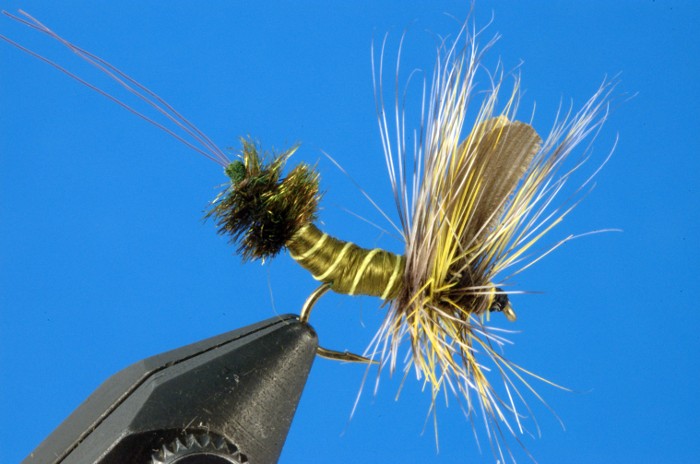
The Stimulator
On an earlier page I promised to mention any fly inventor controversies I was aware of, but not necessarily to settle them. With the Stimulator I up the ante. I'm going to dodge the controversy almost entirely. There is debate about who first invented this great fly. In this case I won't say anything about who or what. I've invented (in my mind anyway) a long list of oddball flies. But almost every one can be seen as an elaboration on earlier works. That's how it is for all of us. We are were we are today because of all of us.
So perhaps the inventor doesn't really matter. We all love this graceful, high floating easy-to-see dry fly that works both as an all-purpose attractor and as generic stonefly adult, in all imaginable sizes and colors.
It's worth mentioning too that although the Stimulator is the current 2022 state of the art for floating not foam-bodied stonefly adults, it can also be seen as a smooth step-by-step evolution from the Picket Pin to the Dan Bailey Bi-Fly to Pat Barnes's Sofa Pillow. And then on to today' Stimulator, with one significant side fork a few years back for Cal Bird's great Stonefly. Which I still tie and admire.
Grasshopper Fishing
The big hopper trend shift in this period was of course foam. My dad loved the Joe's Hopper and was late to make the move to foam. I tried to get to be more reasonable but he was so married to his career late in life he didn't fish much anymore, and when he did fish he wanted it to be the way it always had been. Which for him meant Joe's Hoppers. When he did retire and my folks finally moved to Bozeman it wasn't so hard to catch his attention anymore. I gave my dad a hand full of foam hoppers. He eventually caught a big one were Thompson spring creek empties into the East Gallatin. Joe's Hoppers were history from that moment on.
One of the things I made in those days--that nobody else was back then, in the early 1990s--was absolutely giant hoppers. Some of the guides at the Yellowstone Angler laughed a little at first. But not for long. We do have giant locust like hoppers in Montana, as long as man's thumb. When guiding on the spring creeks I liked to catch them occasionally, pinch the head a bit and then toss it in the water. They never went more than ten feet before they got gobbled. I remember guiding a party of four at DePuy's one day with Paul Rice. The hatch was basically over for the day, a time when most people think they have to switch to tiny black beetles or 3/4" inch long LeTort hoppers. I had my guy put on a giant fat 2" inch long yellow foam hopper. A big rainbow hit so hard my guy panicked and pulled too hard on the rod. And broke it off. Paul said it sounded like a brick hitting the water.
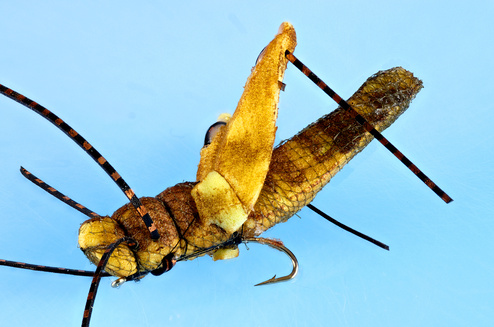
I still tie my own hopper designs but I don't think it matters much. The industry has pretty much settled on the Chubby Chernoble now. They are good flies. You can even buy big ones now too, although none of them quite as big as the ones I tie. I like Chubbies. I make them. I do have a few modifications that make them a little faster and easier to tie. I'll try to get some video plugged in here eventually. One of the best things about Chubbies are the big bushy unnaturally white wings sticking straight up. You can see them from a half a mile away and the fish still bite. It does make you wonder what the fish see up on the surface. Is it just a characteristic outline with familiar leg-like dimples? The Chubby is a good fly. A ton of them get sold every year.
Hopper Dropper rises up to the surface
One of the reasons I tied such big hoppers was my discovery of the Hopper Dropper rig. I learned about Hopper Droppers from my guiding colleague Chuck Tuschmidt. Actually from one of his steady customers from Ottawa. Chuck was busy that day so his customer (I can't remember his name) got me instead of Chuck. We had a good day at DePuy's. That guy at one point rigged himself up with a deer hair hopper and a small not weighted black Woolly Worm. He proceeded to catch quite a few fish that way. I asked him about it. "Chuckie showed me this last year," he said. Damn that son of a gun I thought. Why didn't he (Chuckie) tell me about this too? We do have to keep some secrets I guess.
You can't float much weight with deer hair so I immediately started making mine as foam hoppers. Then I could use use weighted Woolly Buggers below. Foam was pretty new then. I did make big foam hoppers. In the years since I have only a few times fished with a red plastic bobber. I didn't much like it when I did. I use a foam hopper dropper rig instead. The hoppers don't catch many fish but the few they do catch are often the biggest fish of the day. Chubbies work fine for hopper dropper rigs too. That's one reason they are so popular. I don't fish that way as much as I once did. A big foam hopper will put fish down. You get at most two drifts with a giant hopper. If they haven't taken by then they won't. If you fish two wet flies without any bobber mechanism at all you can stay in one spot a lot longer. I like that a lot, now that I'm older.
Clouser Bob Clouser 1987 Pennsylvania
Wikipedia:
I believe that this pattern is the most important and effective underwater fly developed in the past 20 years. During the past three years I have been able to catch 63 species of fish in fresh and saltwaters around the world with this pattern!
Lefty Kreh 1994 in The Professionals' Favorite Flies[4]
I've been a big fan of relatively sparsely tied bucktail and synthetic fiber streamers more or less forever. I wrote a piece in Fly Tyer in something like 1985 called "Fast Sinking Streamers." About the same time Bob Clouser invented the Clouser Minnow. Part of his genius was somehow knowing how important the color chartreuse was. It took me a decade after he invented the Clouser to finally realized the same. His fly too, I think, will gradually make its way into the Hall of Fame ranks, among flies that will last forever. If it hasn't already.
Chartreuse--like blue--is interesting to me because it's impossible to pigeon hole either of those colors into an even remotely Matching the Hatch argument.
Zebra Midge
The Zebra Midge was originated by Ted Wellings, a guide on the Colorado River at Lee's Ferry Arizona in 1996, or so the story
The Zebra Midge is one of my favorite flies because, somewhat like the Prince Nymph, its exaggerated high contrast appearance makes it at least somewhat not realistic, like a bright shining counter example to Matching the Hatch. It sure is a good fly. I use Zebra Midges at midge time but I lso them, and slightly more soft hackle versions of the Zebra Midge at Blue Winged Olive Time. One of the cool things about fly fishing is its complexity. Simplicity has its place in the grand scheme of things too. But complexity keeps it interesting. There are so many flies and variations of flies a guy can use to catch fish. There is always something new to turn to. And there are required stand byes too. like the Zebra Midge.
Bead Heads and the Copper John
Bead heads have probably been around forever but it wasn't until the late 1980s when their popularity really took off. John Barr's 1990s Copper John invention shifted that V8 into overdrive. Bead Heads are dominant now, with the Copper John leading the way. I tie a zillion bead heads. The Three Dollar Dip is hard to beat. It's one of my favorite flies. I even like to tie blue Dips. There is no such thing as a blue nymph. But blue flies sure do work well.
Bead heads can be made small and relatively light or as big river skull crackers. Some of the early 1080s "Euro Nymphs" or "Czech Nymphs" were tied with lead or copper wrapped bodies but almost everybody uses tungsten beads now. Or, in the case of the now vererable Copper John you can use both. Tiny spring creek Pheasant Tails with miniature beads are a useful way to sink just a few inches down from the surface tension. Big double-beaded stonefly nymphs can be used as Spark Plug Flies in fast deep runs on big freestone rivers like Montana's Madison River, with a smaller, lighter Prince Nymph or Gold Ribbed Hare's Ear trailing 18" inches or so behind the Sparkplug fly. Versatility is power.
Soft Hackles
Speaking of bead heads I mentioned to Sylvester Nemes once--at a fly tying demo at the Bozeman Angler--that his flies had made a huge impact on Montana fly shops: there were soft hackle wet flies for sale in every store in the state. "But most of the soft hackles you find in the stores are beadheads," I pointed out. "Do you ever tie your flies as beadheads?" I asked.
Syl peered up at me over the tops of his half frame magnifiers and asked "Why don't you just get a spinning rod. No really," he said. Get an ultra light spinning outfit. You'll be much happier." I almost laughed. I thought he was putting me on and that kind of humor is right up my alley. But it turned out he was dead serious. Phew.
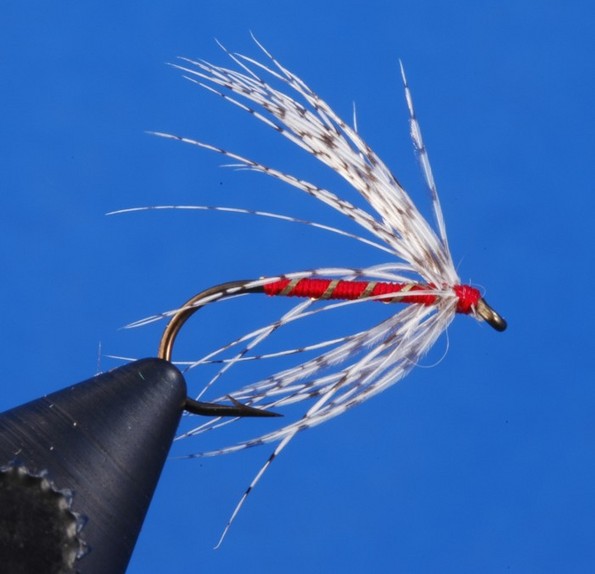
I'm still a big fan of Syl's flies. They're all so beautifully proportioned with carefully chosen color schemes and clean, sharp, accurate wraps. It's impossible not to smile when you see the real thing up close.
Subtle color differences are extremely important to Syl. What look like slight body color and hackle variations on the same pattern to me represent different flies with different names to Syl, for fishing in different habitats on different rivers.
I visited Syl at his house once. A mutual friend took me over to visit. I wanted to hit Syl up for a chance to photograph his flies. That part of the visit never quite worked out. But it was a wonderful day just the same. We spent the afternoon opening fly boxes and talking about flies. His fly collection was astounding. He had thousands of flies tucked neatly away in dozens of labeled boxes. Each fly had a name, penned onto a slip of paper for each bin in the box, all with names like Pemberton, Watchet, Green Tail, Yellow Spider, etc.
Syl had been an advertising copy writer before he retired. He was an astonishingly talented photographer. The walls of his house were covered with Ansel Adams quality black and white prints with black blacks white whites and a long range of grays in between. He had photographs of landscapes and city sidewalk scenes. Like many disciplines the photography community includes all types. Some are technically near perfect while others are perhaps less sharp but clearly display a more artistic eye. Syl had both.
Syl's flies were a sight to behold. My approach to wet flies isn't so disciplined. I don't think about small wet flies by name so much as by color and shape category. And I don't really distinguish between wet flies and small nymphs either. I tend to think more in terms of color schemes layered onto Hare's Ears, Pheasant Tails, Serendipities, Rock Worms and "Soft Hackles." My soft hackle patterns usually have a bead, sometimes behind the hackle and sometimes in front, married to a few basic body types and that's about it.
Soft hackle wet flies sell like hot cakes all over the State of Montana. Now and for a long time to come I suspect.
Serendipity Three Dollar Dip and Blue Flies
A California guy named Ross Merigold apparently invented the Serendipidy 1987 or so, primarily for fishing the Madison River. I first fished a Serendipity, a blue one as it turned out, on an April rainbow spawning expedition to the Gray Reef section of the North Platte with a friend I have since lost touch with: Wayne, a systems administrator from Fort Collins. Wayne and I would occasionally meet in Wyoming to fish for a few days. Wayne would drive North for Colorado and I would drive South from Montana.
When I got to the Gray Reef dam a little before noon I felt like turning around and driving home. Gray Reef is too close to Fort Collins and Denver. It was April and already way more crowded than anything going in Montana at that time of year. I found Wayne in a busy parking lot and we loaded up my boat. This was going to be a two day camping trip. The minute we started fishing I forgot all about the crowds. In April when the rainbows are finishing up this year's spawn there are a zillion big heavy shouldered rainbows to catch. Why is Montana so famous? This was outrageous. Wayne had me fishing with a light almost violet blue Serendipity, which I fished a few feet behind a heavier spark plug fly.
I asked Wayne about the blue color. I'd never seen a blue fly before. Wayne looked at me for a while without saying anything, as if he was making a calculation. "Oh the blue is nothing. A buddy of mine ties them. He's color blind." I knew right away I was being smoked. I remember stuff like that. I've been fishing blue flies for twenty years now. Ever since.
One of my favorites is a blue Three Dollar Dip, which is a fly first developed by some of Craig Mathews' guides. I have a blue fly too i call the Blue Doo. Blue is good stuff. There might be a pseudo-scientific explanation like "The short wave length of blue light penetrates deeper into the water column and still appears as blue without fading to gray." And maybe not. Maybe just knowing blue is big medicine--for what ever reason--is enough. It is.
Gary LaFontaine
Gary LaFontaine--a graduate of University of Montana--was was a great writer and speaker who made a lot of Western Fishermen smile. I attended one of his presentations at Dave Kumleine's Troutfitters I shop in Bozeman, at its original location in the old Red Barn building that is now a Cajun Restaurant. Gary was fun to listen to not only because he had a lot to say but because it seemed impossible for him to contain his enthusiasm about fishing and fly tying. Gary was perhaps the all time champion of "fly fishing as a complex puzzle that had to be unbroken."
I'm still not convinced about the great puzzle theme but he sure was fun to listen to. Gary's one lasting fly was his Sparkle Caddis, whose shiny, puffy, semi-transparent abdomen was meant to simulate the idea of a gas-filled and partially eclosed exoskelaton, surrounding a hatching or emerging caddis fly. Cool fly.
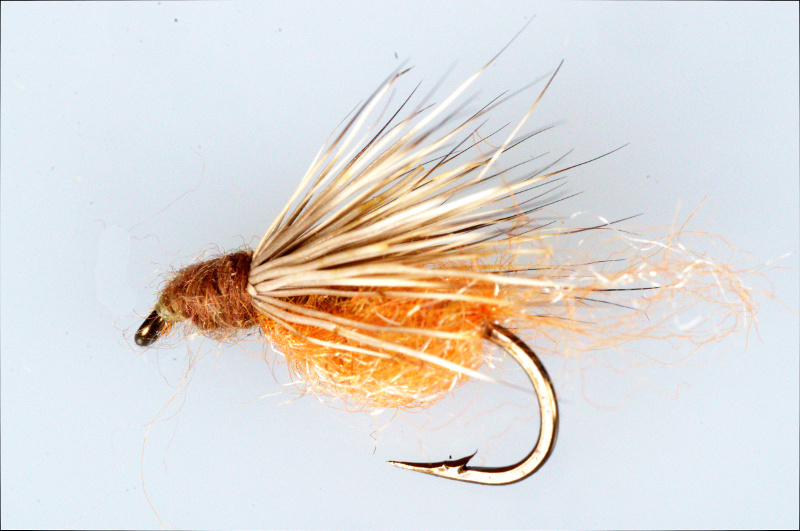
George Anderson
George Anderson is one of the West's coolest guys, and one of the best fishermen to ever hold a fly rod. George's slide show can be exhausting. George is a top-nothch photographer but it takes himn all afternoon long to show all the big fish pictures he has. I worked for George during the only two years he competed in the Jackon Hole One Fly Contest. George won both years with second place a half a mile behind. George is built like a tree stump but he is a fast agile and athletic man. Watching Goege Ski or race motor cycles was sight to behold. George was a good boss too who treated his guys well. And also a hell of fly tyer.
When I worked at the Yellowstone Angler we sometimes made jokes about the George''s Brown Stone but only as a way to tease our favorite boss. We all used this fly and it made good tip money for us too. Al Troth loved the George's Brown Stone too. And used it too. Al's catalogue offered versions of the George's Brown Stone with and without white rubberlegs.
As a Yellowstone River Guide I and all the guys I worked with liked the rubberleg version best. I love this fly. I usually tie the George's Brown Stone and the venerable Bitch Creek together because my body weaving skills are weak. And once I get my weaving fingers going I usually want to finish off a full year's supply all at once.
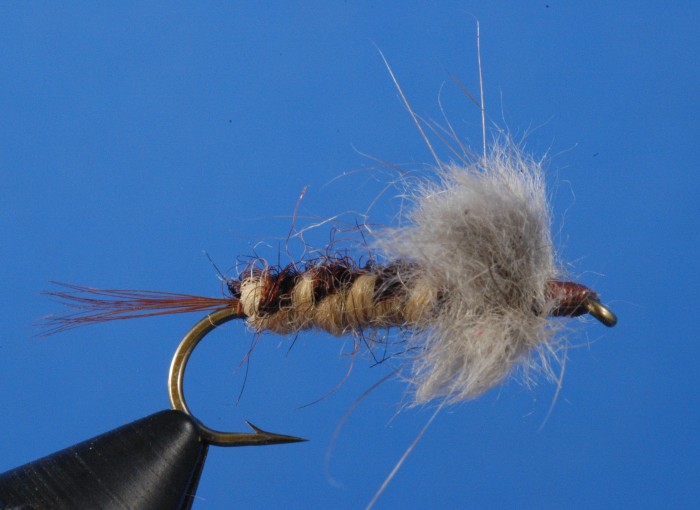
George's son Jamie runs the store now. I stopped in to chat chat with Jamie not too long ago. Jamie gave me the following rubberleg version of his dad's fly but he did take time to trim the legs back a bit with scissors first.
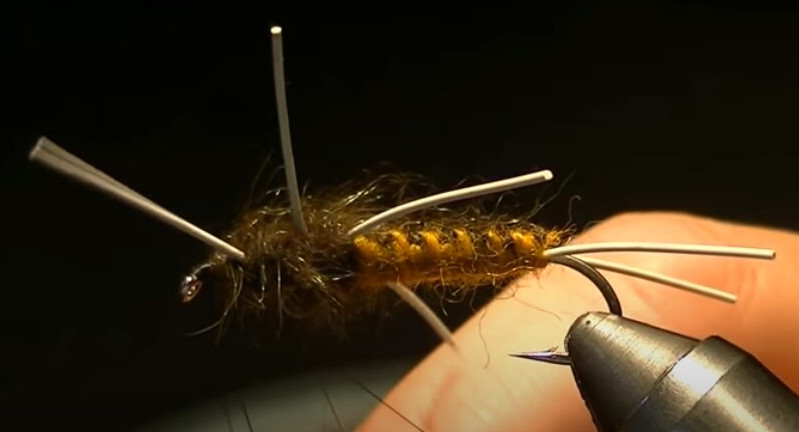
Irrigation Takes Its Toll
I feel uncomfortable being the bearer of bad news. I'd much rather talk about what makes me smile, like good new fly designs from all over the world. There are some issues we have to face up to. Center pivot irrigation systems, irrigation ditches and ever more powerful diesel water pumps have dramatically began to degrade the lower reaches of our most treasured rivers, all over the West and not just in Montana. The Jefferson River in particular has suffered terribly. The Jefferson used to be a semi-secret treasure trove of big fish, used only by locals because it's just a bit too far from all the major tourist destination towns. The Jefferson still has a bit of good fishing up high, closer to Twin Bridges, in the early season. Down near Cardwell what used to be a brown trout Riviera is now a silted carp land that gets too warm for trout to survive in August. Below the canyon where the Lewis and Clark Caverns are it's even worse. I don't know what else to say other than activism and conservation have to become a part of our lives.
I mention this here in the Seventies through Turn of the Century section because the yearly degradation of our rivers first became undeniable that long ago. Every year it gets a little worse than the year before.
Dare I mention the forbidden words "Climate Change" or even, god forbid "Global Warming?" Minimum in stream flows need to become a primary focus somehow. Let's try to stand our ground and put up a good fight. We need it badly.
........work this George Grant quote in:
The largest fish I ever took from the Big Hole was a hen brown having a length of 27" inches, girth of thirteen and a weight of seven pounds. it was taken on an Optic Bucktail with a light brown hair wing and an orange wool body.
The riffle from which this fish was taken, just above Glen where the power line crosses the river, was considered to be one of the finest, but now is just a long lifeless silt bottomed backwater formed by an irrigation diversion dam.
The river itself is now dying as a trout stream, just like the wild birds and wildlife that have preceded it.